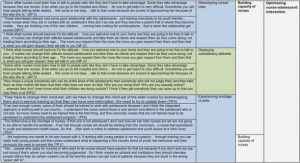Get Complete Project Material File(s) Now! »
INTRODUCTION
The notion that language is used to create meaning is the central premise of this study. Creating linguistic meaning or achieving communication between language participants is a dynamic process involving units, such as the form, context and function of the utterance. Dell Hymes (1967, 1972b) coined the phrase ‘communicative competence’ to refer to the ability of interlocutors to convey and interpret messages, and to negotiate meaning interpersonally within a given context. James Stalker (1989: 182) defines communicative competence as that part of our language knowledge which enables us to choose the communicative system we wish to use, and, when that selected system is language, to connect the goals and contexts of the situation with the structures which we have available in our linguistic repertoire through functional choices at the pragmatic level.
COMMUNICATIVE COMPETENCE
Communicative competence involves knowing not only the language codes, but also what to say to whom, and how to say it appropriately, in any given situation. In other words, it comprises structural, social, cultural as well as functional knowledge that is required in verbal interactions. Language in this paradigm is not viewed as the property of an individual, but as one of the many shared codes or symbolic systems that members of a society use for their daily survival. This concept of communicative competence is consonant with a semiotic approach to language, which holds that language consists of arbitrary symbols whose semantic values have been agreed upon by its users. Known as the ‘functional approach’ to language, communicative competence is a reaction to the definition of language competence as more of a mental attribute (Chomsky, 1957, 1965, 1980).
LANGUAGE
There is no shortage of attempts to articulate the unique qualities of language. (See, for example, Jakobson [1956], Noam Chomsky [1972 and1975] and John Lyons [1977]). However, one is inclined to concur with H. Robins (1979: 9-4) who notes that language definitions ‘tend to be trivial and uninformative, unless they presuppose…some general theory of language and of linguistic analysis’. In other words, to attempt a perspective-free or bias-neutral expose of language is of limited usefulness and of doubtful relevance to most analyses, unless underpinned by some theories. This comment is well illustrated in a clinically objective semantic-syntactic explanation or meaning of the word ‘language’. Exploiting the usual semantic-syntactic procedures of establishing meaning: componential analysis, identifying different relationships among lexical items, derivational backtracking, application in contexts, and so on, all leave one with a distinct feeling of dissatisfaction and bewilderment, according to Robins (1979: 9-14).
FUNCTIONS OF LANGUAGE
In the simplest sense, the word ‘function’ may be synonymous with the word ‘use’ or ‘meaning’. People perform activities with their language: that is, they expect to achieve an objective in speaking, writing, listening and reading. Competence in language is not simply the mastery of forms of language but the mastery of forms in order to accomplish the communicative functions of language, such as, to apologise, to greet, to disagree, to accuse, to warn and so on. Mastery of structural regularities of language remains a very passive asset if speakers do not exploit these forms for the purpose of transmitting and receiving thoughts, ideas and feelings between speaker and hearer or writer and reader. While forms are the manifestations of language, functions are the realisation of those forms.
Dedication
Acknowledgements
Abstract
CHAPTER ONE: FORM AND FUNCTION OF UTTERANCES
1.1 Introduction
1.1.2 Units of Analysis
1.1.2.1 Communicative Competence
1.1.2.2 Communication
1.1.2.3 Language
1.1.2.3.1 Socio-pragmatic view versus structural –mentalist notions of language
1.1.2.4 Context
1.1.2.5 Functions of Language
1. 2 Formulation of the Hypothesis
1. 2.1 Hypothesis
1. 3 Objective
1. 4 Theoretical Strategies
1.4.1 Speech Act Analyses and Pragmatics
1.4.2 Issues to be Investigated
1.4.3 Data Collection and Analysis
1.5 Outline of Chapters
CHAPTER TWO: CREATION OF MEANING AND COMMUNICATIVE COMPETENCE
2.1 Introduction
2.2 Meaning
2.2.1 Linguistic Meaning
2.2.1.1 Syntactic meaning
2.2.1.2 Semantic Meaning
2.2.1.3 Pragmatic meaning
2.3 Communicative Competence
2.3.1 Components of Communicative Competence
2.3.1.1 Linguistic Competence of Communicative Competence
2.3.1.1.1 Grammatical Competence
2.3.1.1.2 Discourse Competence
2.3.1.1.3 Socio-linguistic Competence
2.3.1.1.4 Strategic Competence
2.3.1.2 Psycholinguistic Components of Communicative Competence
2.3.1.2.1 Knowledge
2.3.1.2.2 Skills
2.3.1.3 Communicative Competence in cultural domain
2.4 Summary
CHAPTER THREE: EVALUATION OF COMMUNICATIVE COMPETENC
3.1 Introduction
3.2 Units for Description and evaluation of communicative competence
3.2.1 Event: Language and Text
3.2.1.1 Properties of Language
3.2.1.1.1 Duality
3.2.1.1.2 Productivity
3.2.1.1.3 Discreteness
3.2.1.1.4 Semanticity
3.2.1.1.5 Displacement
3.2.1.1.6 Interchangeability
3.2.1.1.7 Specialisation
3.2.1.1.8 Cultural Transmission
3.2.1.1.9 Learnability
3.2.1.2 Text
3.2.2 Situation: Context of Texts
3.2.3 Act: (Function)
3.2.3.1 Classification of Speech Acts
3.2.3.1.1 Classification: Austin
3.2.3.1.2 Performatives
3.2.3.1.3 Classification: Searle
3.3 Indirect Speech Acts
3.3.1 Sentence Meaning and Utterance Meaning
3.3.2 Inference and Implicature
3.3.4 Conversation Principles
3.3.5.Summary
CHAPTER FOUR: ANALYSIS
4.1 Introduction
4.2 Qualitative Research
4.2.1 Cross-Cultural Analysis
4.3 Methodology
4.3.1 Sample Collection
4.3.2 Participants
4.3.3 Questionnaire
4.3.4 Data Analysis
4.3.4.1 Evaluation Criteria
4.4 Presentation of Results: Part One
4.4.1 Communicative Competence of Respondents
4.5 Presentation of Results: Part Two
4.5.1 Section A: Requests
4.5.1.1 Utterance 1
4.5.1.2 Utterance 2
4.5.1.3 Utterance 3
4.5.1.4 Utterance 5
4.5.1.5 Utterance 9
4.5.2 Section B: Complaints
4.5.2.1 Utterance 4
4.5.2.2 Utterance 6
4.5.2.3 Utterance 7
4.5.2.4 Utterance 8
4.5.3 Section C: Statements
4.5.3.1 Utterance 10
4.5.3.2 Utterance 11
4.5.3.3 Utterance 12
4.5.3.4 Utterance 13
4.5.3.5 Utterance 14
4.5.3.6 Utterance 15
4.5.3.7 Utterance 16
4.5.3.8 Utterance 17
4.5.3.9 Utterance 18
4.6 Conclusion
CHAPTER FIVE: INTERPRETATION
5.1 Introduction
5.2 Conclusions
5.2.1 Nature of Communication
5.2.2 The Limitations of Speech Act Theory
5.2.3 Respondents
5.2.4 Samples
5.2.1.1 Grammatical Conclusions
5.2.2.1 Pragmatic Conclusions
5.3 Summary
CHAPTER 6: RECOMMENDATIONS
6.1 Introduction
6.2 Recommendations
6.2.1 Enhancing Communicative Competence
6.2.2 Enhancing Speech Act Theory as an Evaluative Tool
6.2.3 Further suggestions for Research
6.3 Conclusion
Bibliography
GET THE COMPLETE PROJECT
SPEECH ACT THEORY AND COMMUNICATION: A UNIVEN STUDY




